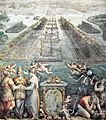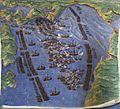Battle of Lepanto facts for kids
The Battle of Lepanto was a very important naval battle. It happened on October 7, 1571. The fight took place near the Greek city of Náfpaktos. This city was known as Lepanto in Italian.
The battle was fought between two powerful groups. One side was the Ottoman Empire. The other side was a group of Catholic nations. This group was called the Holy League. It included the Spanish Empire, the Papal States (lands ruled by the Pope), the Republic of Venice, and the Sovereign Military Order of Malta. The Republic of Genoa and the Duchy of Savoy also joined the Holy League.
A famous writer, Miguel de Cervantes, fought in this battle. He was injured and lost the use of his left hand. This earned him the nickname "the one-handed man of Lepanto." Cervantes was very proud of fighting there. He called it "the most memorable and greatest occasion." He also wrote about it in his famous book, Don Quixote.
Contents
What Was the Battle of Lepanto?
The Battle of Lepanto was a major sea fight. It was one of the biggest naval battles in history. It involved hundreds of ships and thousands of soldiers. The battle was a clash between two different cultures and religions. It showed the power of naval warfare in the 16th century.
Who Fought in the Battle?
The two main sides were:
- The Ottoman Empire: This was a large empire based in modern-day Turkey. They had a very strong navy.
- The Holy League: This was an alliance of several European Catholic states. They joined forces to stop the Ottoman expansion.
The Holy League's Members
The Holy League was made up of:
- Spanish Empire: A powerful kingdom with a strong army and navy.
- Papal States: The lands directly controlled by the Pope.
- Republic of Venice: A wealthy city-state known for its naval power and trade.
- Sovereign Military Order of Malta: A military and religious order of knights.
- Republic of Genoa: Another important Italian city-state with a navy.
- Duchy of Savoy: A state in what is now Italy and France.
Why Was the Battle Important?
The Battle of Lepanto was very important for several reasons. It was a major victory for the Holy League. It stopped the Ottoman Empire from expanding further into Europe by sea. This battle also showed that the Ottoman navy could be defeated. It gave hope to many European nations.
Impact on History
- Naval Power Shift: The battle changed the balance of naval power in the Mediterranean Sea.
- European Morale: It boosted the spirits of European nations. They had been worried about Ottoman control.
- Technological Advances: The battle also highlighted the importance of new ship designs. The Holy League used galleasses, which were larger and had more cannons.
Images for kids
-
The banner of the Holy League, flown by John of Austria on his flagship Real. It is made of blue damask interwoven with gold thread, of a length of 7.3 m and a width of 4.4 m at the hoist. It displays the crucified Christ above the coats of arms of Pius V, of Venice, of Charles V, and of John of Austria. The coats of arms are linked by chains symbolizing the alliance.
-
Order of battle of the two fleets, with an allegory of the three powers of the Holy League in the foreground, fresco by Giorgio Vasari (1572, Sala Regia).
-
Depiction of the Ottoman Navy, detail from the painting by Tommaso Dolabella (1632)
-
The Victors of Lepanto, John of Austria, Marcantonio Colonna and Sebastiano Venier (anonymous oil painting, c. 1575, formerly in Ambras Castle, now Kunsthistorisches Museum, Vienna)
-
Felipe II offers Prince Fernando to Victory by Titian, c. 1572–1575, Museo del Prado, Madrid
-
Monument to John of Austria in Messina
-
The Allegory of the Battle of Lepanto by Paolo Veronese (c. 1572, Gallerie dell'Accademia, Venice)
-
The Battle of Lepanto by Andrea Vicentino (c. 1600, Doge's Palace, Venice)
-
The Battle of Lepanto by Juan Luna (1887, Spanish Senate, Madrid)
-
The Battle of Lepanto by Tintoretto
-
The Battle of Lepanto by Giorgio Vasari
See also
 In Spanish: Batalla de Lepanto para niños
In Spanish: Batalla de Lepanto para niños



















